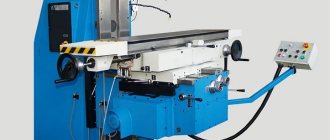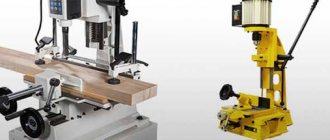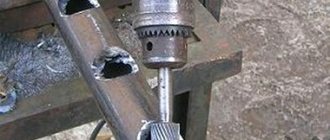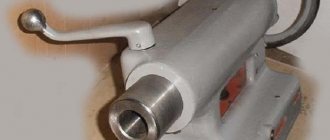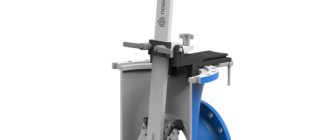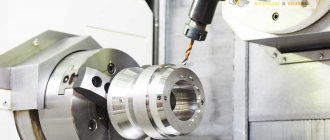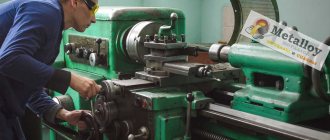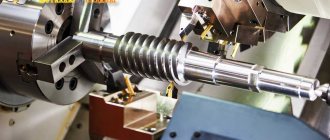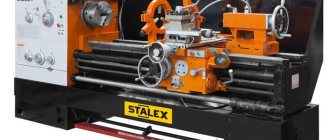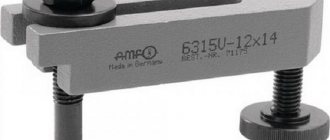Grinding machines are a separate category of metalworking machines that are designed to perform grinding operations. There are several main types of these machines, which differ in design, operating principle and type of surfaces processed. Let's consider each of them separately.
Principle of operation
The operating principle of the grinding unit is the rotational movement of the cutting tool , as well as the reciprocating motion of the board. The disk rotates at high speed and in one go it can remove a thin layer of metal, and if you constantly and carefully move back and forth, then rather slow processing of the entire surface of the part will be ensured.
The grinding depth, which affects the quality of the surface, will be achieved differently on different machines. It can usually be adjusted by automatically moving the desktop up or down. On modern models, the location along the vertical axis is changed using a special working head, which has a cutting tool.
Application area
Grinding is the process of processing a workpiece with various abrasive materials for metal to give it the required accuracy, regardless of whether the part is mass-produced or made by hand. This occurs due to the fact that when the tool comes into contact with the workpiece, a thin layer of metal shavings is removed from its surface. The process is carried out in stages until the required accuracy is achieved. In addition, the anti-corrosion properties of the product are increased, the appearance is improved, even a homemade item made with your own hands will have the appearance of a factory one.
Enterprises use two types of grinding machines for metal processing:
- specialized;
- general purpose.
Specialized metal grinding equipment is manufactured for a specific enterprise according to individual drawings and for a specific job. In most cases, general-purpose machines are used, the brands of which are distinguished by processing method:
- external (the grinding tool is in contact with the outer surface of the workpiece);
- internal (the internal part of the part is subjected to grinding - various holes, both through and blind);
- profile (used for finishing of products with complex shapes).
There are brands of devices that can perform several types of processing, but their cost is too high, and the complexity of operating such a unit does not have the best effect on the profitability of production.
Cost of calibration and grinding equipment
The price of the machine is one of the most important parameters when choosing a suitable model. Depending on the features, the purchase will cost from 150 thousand rubles to several million. For a small enterprise, an expensive device may be unaffordable.
The cost is influenced by various factors, but the main ones are:
- modification and year of manufacture;
- functional;
- power of the power plant;
- basic equipment;
- dimensions and weight;
- manufacturing materials;
- additional devices.
To find a model that best meets the requirements, it is necessary to carefully analyze the ratio of price, quality and capabilities of the device.
To reduce the cost of purchasing calibrating and grinding equipment, many enterprises prefer to buy used machines. But this solution is not the most rational. Although the price savings can amount to several hundred thousand rubles, the device loses warranty service. In case of problems, repairs are carried out at our own expense. As a result, the costs of repairs and maintenance may offset the benefits of purchasing a new device. In addition, the service life is a priori reduced.
Combined machines allow you to quickly and efficiently process wooden workpieces. The range of work and the number of actions of calibrating grinding units is much wider than that of standard grinding machines. The devices are indispensable when it is necessary to perform large volumes of work in a short time. The intensity and quality of production largely depend on the characteristics of the unit, so the choice must be made intelligently.
Specifications
You need to understand that for different purposes for processing parts, you can purchase different grinding machines. But, one way or another, when choosing, you should pay attention to some general technical characteristics .
- Drive power.
- The distance from the spindle to the work table, which affects the grinding thickness of the workpiece.
- The worktable travels along the Y and X axes, which provides the width and length of the grinding.
Another very important characteristic is the processing accuracy, as well as the maximum and minimum cross feed and, of course, the size of the work table. You need to pay special attention to these characteristics when purchasing this type of device.
About the types of centerless grinding devices
Machines of this type are usually used for:
- processing of various parts, of any length, with large or small diameters;
- grinding parts with rather complex external profiles.
These machines usually have high productivity and very precise processing. But, unfortunately, for small-scale and small individual productions their use is difficult, since it is quite difficult to re-adjust these devices, since this will require significant time expenditure and highly qualified service personnel.
Such difficulties are associated with the technological features of these grinding machines, for example:
- the existence of leading, grinding grinding wheels in them;
- the presence of special dressing devices that provide the necessary configurations to the surfaces of any wheels (grinding and driving types);
- fixing the fastening of the supporting type of special knives;
- the presence of mechanisms to compensate for feeds of the required type of wheels, processing products;
- setting the required position for loading and unloading types of devices.
Main components and elements of equipment
A special feature of grinding machines is the belt working tool. An abrasive tape acts in this capacity.
The grinding machine also includes the following components:
- Bed. This is a massive base made of thick metal. This part of the machine is responsible for the stability of the equipment. The larger the workpiece, the larger the frame required.
- The driving and driven rollers on which the tape is located. These are hollow products with built-in closed bearings. All rollers are located in the same plane. This condition is necessary to prevent the tape from jumping off. The width of the rollers also corresponds to its size.
- Ribbon. This is the main tool that is responsible for grinding metal. It is located on casters. Has different degrees of grain.
- Tensioner. Good tension of the belt ensures that it does not bend during the metal grinding process. This is ensured by a built-in tension system. By loosening the tension roller it is convenient to replace the belt. This is especially important when changing abrasive tools frequently.
- Transmission. Its presence is possible only on large-sized machines used in large industries. For a private workshop there is no need for it.
- Electrical system, which includes an electric motor with a control unit. Torque is transmitted directly to the roller. A belt drive is used as a transition link. It also regulates the required speed.
- There is a casing on top that protects from flying chips.
If the dimensions of the grinding equipment are large, then a ventilation system is built in. For a small machine such devices are not required.
The simplest homemade machine
A grinding machine can significantly simplify the life of a home craftsman, but it has one significant drawback - the price. It is not difficult to get around this obstacle. Using a minimum of materials and tools, they make simple wood grinding machines with their own hands.
An engine from an old washing machine is best suited as the power unit for a home grinding machine. The choice of device configuration depends on the preferences of the master; the best option for most work in a home workshop is a homemade belt-type machine. It is easy to manufacture and allows you to perform a wide range of work.
To work in a home workshop, it is hardly worth making a stationary machine; it is enough to make a portable device that, if necessary, can be installed on a workbench.
The best material for the frame is a metal corner or square pipe. Connection - welding or bolts. In any case, the frame must be stable, and the engine must be securely mounted on it.
Rollers and tape
To avoid additional costs and not to use a belt drive or gearbox, the rollers are made of different diameters. The exact dimensions depend on the engine speed. If a 1500 rpm engine is used, then the diameter of the drive disk should be about 200 mm, and the tension disk should be 20-40 mm. Working width – 200 mm.
If it is not possible to select ready-made rollers, they can be easily made from thick plywood or chipboard. Blanks 200 x 200 mm are cut out of the sheet and assembled into a package about 250 mm thick. Using a drill, a hole is drilled in the center of each workpiece, the package is tightened with a bolt and ground to a cylindrical shape. The tension roller is also made.
The drive roller is mounted directly on the motor shaft, the tension roller is mounted on the frame. To prevent the tape from flying off during operation, it is advisable to make simple guides - rubber rings from a bicycle inner tube. They are put on the edges of the rollers. If the drive roller is made removable, you get a combined machine; if necessary, an abrasive disk of small diameter can be installed in place of the roller.
It’s easy to buy ready-made belts for a grinding machine in a specialized store. The tape size will most likely be non-standard unless the device was designed for specific consumables, but this can be easily fixed with scissors and glue.
Types and characteristics of grinding machines
Using grinding machines, high-precision operations with high productivity are carried out for processing finished workpieces, grinding necessary parts, and turning complex profiles.
Don't miss: Surface grinding machine: types, device, model reviews
In each case, various methods of grinding metal products at high speed are used, which makes it possible to remove a much larger volume of metal in the same time than with preliminary grinding and then milling.
In the manufacture of electronic and precision computing devices, only such processing makes it possible to make parts from fragile materials such as ceramics and magnetic substances. Therefore, the type and characteristics of grinding machines differ greatly. The grinding and polishing machine is used in laboratories and metallography, and the calibrating machine is used for wood processing.
The grinding process itself on such machines is carried out by rotating the grinding wheel, as well as moving along or in a circle of the workpiece relative to the abrasive. There are two options for moving the workpiece: in a straight line and in an arc.
Cylindrical grinding machines
These machines are designed to perform longitudinal and plunge grinding of metal workpieces of various shapes. They are characterized by high accuracy of the operation. To increase this indicator, it is recommended to select models with an electronic control unit.
Structurally, the equipment consists of two work tables. On the main (horizontal) part, the part is fixed in the centers (chuck) for further rotation. The vertical table contains a spindle head with an installed abrasive wheel. It can be controlled manually or using a CNC unit.
Stages of operation of an internal grinding machine.
- Fastening the part in the centers.
- Setting the initial position of the abrasive relative to the workpiece.
- Starting the rotation of a part with translational movement along the horizontal axis.
- Surface treatment and further displacement of the abrasive to the depth of the removed layer of material.
Depending on the characteristics of the equipment, it can be used for rough or fine grinding. In the second case, the best option would be to use models with an automatic feed system. In this case, the determining parameter will be the rotation speed of the abrasive wheel.
The defining parameters of the machine are restrictions on the size and weight of the workpiece. Thanks to the wide range of settings, equipment of this class can perform all types of grinding.
Changing the location of the abrasive wheel depends on the machine model. In some of them, it can shift not only in the vertical plane, but also in the horizontal. This significantly expands the range of applications.
Internal grinding equipment
They are designed for processing the inside of workpieces with through or blind holes. The main difference from the models described above is the immobility of the workpiece relative to the abrasive. This metal grinding machine is used for processing engine cylinders and similar structures.
Processing occurs due to a movable spindle on which the disk is installed. It transmits to the abrasive not only rotational, but also translational motion. Thanks to this, the internal edges of the workpiece are polished.
Depending on the design and required complexity of grinding, equipment of this type is conventionally divided into the following groups:
- with one spindle. With their help, they process conical and cylindrical products of the correct shape. In this case, the hole does not have to be blind;
- additional edge processing. This function makes it possible to do face grinding simultaneously with internal grinding. To do this, the equipment must have an additional spindle;
- double sided This type of equipment is designed to perform double-sided grinding of through holes in parts.
Internal grinding machines are used for grinding massive products. Thanks to their design and wide functionality, they can perform all types of processing, including final finishing of the internal surface.
Special technical characteristics are the maximum processing length, restrictions on the outer diameter of the workpiece and the values of the maximum and minimum rotation angle of the abrasive in conical products.
One of the problems in operating internal grinding machines is the timely removal of waste from the abrasive area. For this purpose, magnetic devices and special filters are used. Without them, it will be impossible to achieve the desired roughness indicator.
Belt grinding machines
Belt grinding machines are used when it is necessary to finish a finished part to perform finishing operations required by the manufacturing technology.
The equipment is most often used in furniture production for processing wooden products made from various types of wood. If you need to process another material, simply replace the abrasive belt.
The main tasks of belt grinding machines include:
- final leveling of the surface to a certain level of smoothness before opening with varnish or other substances;
- elimination of minor inaccuracies in surface pretreatment (burrs, depressions and elevations, removal of sagging from previous openings);
- grinding of internal surfaces, precise processing of curves on parts.
The belt sanding machine can be used to process parts made of various materials: wood, ordinary and alloy steel, various non-ferrous metals. The parts can be given absolutely any shape: round, square, flat. Using the machine, it is possible to process pipes with a large cross-section.
Don't miss: Wood chisel: purpose, types, selection: types, characteristics, choice
Drum grinders
The main difference between drum grinding machines is that their working element is a tape wound on a special drum.
Other features of the machine include:
- continuously adjustable feed speed from 0.5 to 3 m per minute;
- the ability to easily adjust the processing height using the flywheel;
- powerful electric motor;
- connector for external dust extractor.
Each drum sander requires approximately 2.5 m of belt.
Surface grinding machines
This type of equipment is used for high-precision processing of metal products that have a flat surface. However, on some models, round-shaped workpieces can also be ground. A distinctive feature of the design of surface grinding equipment of any brand is the method of fastening the workpiece. Unlike its cylindrical grinding counterpart, the product is not fixed in a chuck, but directly on the working surface of the machine using a powerful electromagnet (sometimes a homemade magnet made by hand is used).
The group of surface grinding machines are also divided into two types according to the method of operation:
- working with the end surface of an abrasive wheel;
- working on the periphery of the abrasive wheel.
The first group has higher performance, while the second group is able to provide very high accuracy (grade 8-10). Control can be done by a master either with his own hands or using a CNC unit.
One variation of this type of equipment is the belt sander. The working tool in it is a belt-type abrasive. The belt is made in the form of a ring placed between two shafts and can be positioned either horizontally or vertically, but in general the operating principle remains the same. The design of the belt grinding machine assumes the ability to change the speed of the tool when working on metal, which allows you to change processing modes.
You can easily make a belt sanding machine yourself. In the factory version there are the following types:
- with a movable work table;
- with static;
- with a free abrasive belt tool.
A separate niche is occupied by wide-band models for metal, in which the table has a caterpillar shape.
An important element in the design of a belt grinding machine is the presence of a hood, which is necessary to remove metal dust and small abrasive particles.
The choice of abrasive belt tool, the main parameter of which is grain size, also plays a significant role. It is this moment that affects the roughness of the finished product.
When working on a belt sanding machine, you need to ensure that the belt is glued correctly and does not have tears in order to avoid failures.
Honing
The final grinding stage is best done using special honing equipment. Its design is in many ways similar to internal grinding models. The difference is that the workpiece is not mounted on a special device. The spindle is also longer for more thorough grinding.
To fully perform its functions, nozzles with different configurations and abrasive grain sizes can be installed on the spindle. Processing of the workpiece is performed manually or using an automated system. In the first case, the spindle can move relative to its axis. The automatic mode provides mechanisms for maximum finishing of the workpiece surface.
To select the optimal model, it is necessary to take into account the following design nuances:
- spindle parameters – its length and number of degrees of freedom;
- the ability to perform grinding in horizontal and vertical planes;
- number of spindles. This affects not only the quality, but also the grinding speed.
A blank mounted on a spindle is used as a processing tool. Its design provides connectors for attaching abrasive bars of various configurations.
To achieve optimal results during the honing process, liquid is supplied to the treatment area. It performs several functions: it prevents heating of the surface and removes abrasive particles that have broken off from the bars.
Centerless grinding models
The operating principle of these machines is based on the transmission of torque from the drive wheel to the workpiece. It is not attached rigidly in the centers. The degree of pressure on the working abrasive is controlled by adjusting the position of the driving wheel.
Most often, an abrasive tape is used as a processing material. It is installed on the surface of the working circle. This operating principle allows you to quickly reconfigure the equipment to activate another mode.
Advantages of using centerless grinding units:
- high processing speed. Compared to the models described above, it increases by 1.5-2 times. This makes it possible to grind thin-walled products from soft metals;
- For massive workpieces, the method of fixation on rigid supports can be used. In this case, the spindle drive has a cantilever design, and its rotation is carried out due to the influence of a magnetic chuck. This reduces the likelihood of beats occurring. There is also virtually no load on the walls of the workpiece, which is the main reason for its partial deformation along the edges, which is typical when using classic spindles;
- possibility of using axial supports. They hold the structure along its axis of rotation. This way you can sand over the entire outer surface.
Such equipment is equipped with an automated function control complex. This is a necessary measure, since it is almost impossible to achieve a good finish grinding result using manual mechanisms for this method.
The video shows an example of the operation of an automated centerless grinding line:
Don't miss: Polishing stainless steel - methods and their differences + video
Other types of equipment
Gear grinding machines are highly specialized devices. They bring the gears and wheels after hardening to the desired configuration in the case of a driver and remove scale. They are installed in areas with gear hobbing equipment, as finishing ones. The stone can be narrow, flat or shaped in the form of a depression or a circle.
Profile pipes are processed along the plane and ends on band machines. The working tool is tapes coated with a layer of abrasive. They fit on 2 rollers:
- leading;
- worker.
The part is fed into the work area manually. Metal belt grinding machines are used for welding and metalworking work, grinding the ends and surfaces of square pipes.
Grinding machines also include sharpening machines. Diamond wheels remove a thin layer from the surface of the cutter, sharpening them at the desired angle.
Honing
Operation of the honing unit
The final grinding stage is best done using special honing equipment. Its design is in many ways similar to internal grinding models. The difference is that the workpiece is not mounted on a special device. The spindle is also longer for more thorough grinding.
To fully perform its functions, nozzles with different configurations and abrasive grain sizes can be installed on the spindle. Processing of the workpiece is performed manually or using an automated system. In the first case, the spindle can move relative to its axis. The automatic mode provides mechanisms for maximum finishing of the workpiece surface.
To select the optimal model, it is necessary to take into account the following design nuances:
- spindle parameters – its length and number of degrees of freedom;
- the ability to perform grinding in horizontal and vertical planes;
- number of spindles. This affects not only the quality, but also the grinding speed.
A blank mounted on a spindle is used as a processing tool. Its design provides connectors for attaching abrasive bars of various configurations.
To achieve optimal results during the honing process, liquid is supplied to the treatment area. It performs several functions: it prevents heating of the surface and removes abrasive particles that have broken off from the bars.
Belts for belt sanding machines
Both in production and at home, grinding machines are often used, the working tool of which is a cloth belt with a layer of abrasive powder. The basis of such tapes is dense material (calico, twill) or special paper, and the abrasive layer is fixed on them using an adhesive composition.
The effectiveness of using such a tape depends on a number of parameters: the density of application of the abrasive powder and the composition of its grains. Belts on which the powder occupies no more than 70% of their area are more effective. This is explained by the fact that the processed material does not get clogged between the abrasive grains of such a tape. Both natural and artificial materials can be used as an abrasive powder applied to the working surface of the belt, but all of them must have high hardness.
Belts installed on a grinding machine are classified by a number indicating the size of the abrasive grains, expressed in hundredths of a millimeter. The reliability and effectiveness of such a tape also depends on the type of glue that is used to fix the abrasive grains. Today, two types of such glue are used: flesh and synthetic resin.
As a rule, belt sanding machines are used in woodworking enterprises. The belt on such machines can also be attached to reels, which allows them to be classified as cylindrical grinding equipment. But in most cases, these machines are made universal; they can be used to process wooden parts either using a belt or using grinding wheels.
How to choose the right machines?
There are several selection rules. Based on them, you will be able to choose good equipment for work or hobby:
- Engine power.
- Maximum thickness of workpiece processing.
- Possibility of precise adjustment of the processing angle.
- Machine dimensions.
- The maximum size of workpieces that can be processed on the machine.
The higher the engine power, the better. However, excess power can come with high electricity costs. If you operate the equipment frequently, your electricity consumption will increase significantly. The maximum possible processing thickness is important for machines where the gap is set. First of all, this is calibration equipment. For grinding and grinding machines and belt machines, this does not matter, as does setting the angle of processing of the parts.
An important selection criterion is external dimensions. The machine can weigh up to several tons. Professional machines intended for use in production cannot be placed in a small workshop or garage. There is a lot of equipment available for home use that is compact in size. They use cheap consumables. Such installations have sufficient functionality to perform everyday tasks.
